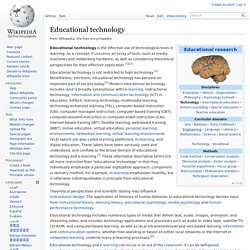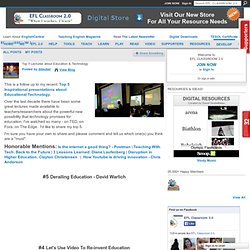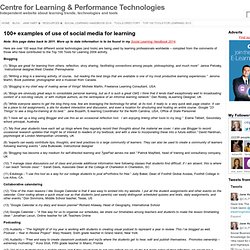

«Free digital tools in Blooms. This list is distinctive as the resources are a) free and b) almost exclusively browser based.

The list is also sorted by Blooms, meaning you are able to more easily consider your student outcomes FIRST. There are a few exceptions. A number of resources listed offer ‘pro’ services, but are still particularly useful using the free services they offer. There are a couple of software downloads included. Notably, Jing and Audacity, which are free and powerful products in the classroom and I felt compelled to include them. Have a favourite that’s missing? 25 Ways Teachers Can Integrate Social Media Into Education. 50 Powerful Ways To Use Skype In The Classroom. Added by Katie Lepi on 2012-11-15 Collaborate! Meet with other classrooms : One of the most common projects educators utilize Skype for is setting up exchanges with classrooms around the world, usually for cultural exchange purposes or working together on a common assignment.
The program’s official site provides some great opportunities to meet up with like-minded teachers and students sharing the same goals. Practice a foreign language : Connect with individual learners or classrooms hailing from a different native tongue can use a Skype collaboration to sharpen grammar and pronunciation skills through conversation. Peace One Day : Far beyond classroom collaborations, the Peace One Day initiative teamed up with Skype itself and educators across the globe to teach kids about the importance of ending violence, war, and other social ills. Communicate! Connect! Art crits : Schedule time with professional artists and receive thorough crits about how to improve a piece.
Comments are closed. Educational technology. Educational technology is the effective use of technological tools in learning.

As a concept, it concerns an array of tools, such as media, machines and networking hardware, as well as considering theoretical perspectives for their effective application.[1][2] Educational technology includes numerous types of media that deliver text, audio, images, animation, and streaming video, and includes technology applications and processes such as audio or video tape, satellite TV, CD-ROM, and computer-based learning, as well as local intranet/extranet and web-based learning.
Information and communication systems, whether free-standing or based on either local networks or the Internet in networked learning, underlie many e-learning processes.[6] Educational technology and e-learning can occur in or out of the classroom. It can be self-paced, asynchronous learning or may be instructor-led, synchronous learning.
Definition[edit] Scope[edit] Related terms[edit] History[edit] Cassandra B. Theory[edit] An Ed-Tech Guide for Teachers and Technologists. “Ed-Tech” stands for educational technology, it is about the education-focused technologies or using general technologies for education purposes.

Looking back on 2012, a review on Top 10 Educational Technologies of 2012 (from School Library Journal) is a must-read, and Top 100 Tools for Learning from C4LPT (2012) is the comprehensive list of top Ed-Tech tools from C4LPT. Looking forward to next year, MIT Enterprise Forum gave us the highlight on Converging Trends and Opportunities of K12 EdTech, and The Open University proposed ten innovations that have the potential to provoke major shifts in educational practice: Innovating Pedagogy 2012 from The Open University. Back to the basics of Ed-Tech, Audrey Watters(Hack Education) had created “The Audrey Test” in 2012 – … some of the things I think techies (engineers and entrepreneurs) should know about education. Top 5 Lectures about Education & Technology. Learn About EnglishCentral Teaching English Magazine Read The Latest Newsletter Digital Downloads TESOL Certificate Supporter Top 5 Lectures about Education & Technology This is a follow up to my recent: Top 5 Inspirational presentations about Educational Technology.

Over the last decade there have been some great lectures made available to teachers/researchers about the powerful new possibility that technology promises for education. I've watched so many - on TED, on Fora, on The Edge. I'm sure you have your own to share and please comment and tell us which one(s) you think are a "must". Honorable Mentions: Is the internet a good thing? #5 Derailing Education - David Warlich #4 Let's Use Video To Re-invent Education #3 Copyright problems in the Digital Age - Richard Stallman #2 The Learning Revolution - Ken Robinson #1 The Future Of Learning - Sugata Mitra If you liked this you might enjoy: Top 5 inspirational speeches for teachers Views: 292. 100+ examples of use of social media for learning. EmailShare 0EmailShare Note: this page dates back to 2011.

More up to date information is to be found in my Social Learning Handbook 2014. Here are over 100 ways that different social technologies (and tools) are being used by learning professionals worldwide – compiled from the comments of those who have contributed to the Top 100 Tools for Learning 2009 activity. Blogging (1) “Blogs are great for learning from others, reflection, story sharing, facilitating connections among people, philosophizing, and much more” Janice Petosky, Instructional designer,West Chester, Pennsylvania (2) “Writing a blog is a learning activity, of course, but reading the best blogs that are available is one of my most productive learning experiences.”